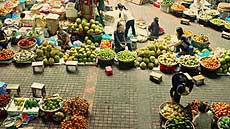Despite the proliferation of modern shopping complexes and commercial centres in Hanoi, the old fashioned Chợ Hôm (Hom market) is still bustling with business every day of the week.

No one knows exactly when Chợ Hôm first appeared. Unlike well documented colonial buildings and historical pagodas around town, markets take shape on the streets of the capital in a gradual process and tend to snowball over time, often with a cluster of small stalls turning into a full-blown market as merchants try to meet the local demand.
What we do know is that the market is a survivor. It has seen many ups and downs throughout its history, and it still survives today. Even as the city transforms into a modern metropolis replete with shopping malls and complexes flogging designer brands, Chợ Hôm continues to hold on.
Covering a large square of land at the intersection of Tran Xuan Soan and Pho Hue Streets, this market is as much of an iconic address as the Sofitel Metropole or the Turtle Tower on Hoan Kiem Lake.
Chợ Hôm provides a window into old-school Hanoi. It is a bustling market, which has become a rare sight in Hanoi with the disappearance of many of the city’s old markets.
The name "Hôm" is a bit confusing. Some people say it was called Hom Market because it originally opened in the late afternoon, while others think that Hom refers only to the fabric market, the predominant product sold in the market and surrounding area.
According to Nguyen Vinh Phuc, an 84-year-old “walking encyclopedia†on all things Hanoian, the market opened back in the late 19th century, and only in the late afternoon selling cheap daily essentials.
Phuc is not a native of Hanoi, but for the last 55 years he has been known as an eminent historian and cultural researcher of the national capital. His passion for Hanoi has enabled him to publish numerous books about the city, its customs and its people.
He believes that, as the city expanded and developed in the early 20th century, the market also developed and started to open all day long. People in the neighbouring area often brought poultry to sell in the two adjacent gateway markets, which is why Phố Huế used to be called Hà ng Gà -Chợ Hôm (Chicken Street-Hom Market).

Today, the market is known for selling quality items from all over the country, including fresh vegetables, foodstuffs and fabric, so prices are often higher than in other markets. Its seafood is the best of all things on sale. Here you can find live fish, shrimp and crab that cannot be found anywhere else and the vegetables look as if they’ve been just picked from the farm.
Minh Tu, a 50 year-old poultry seller who has worked at the market for 10 years, says: “Housewives like shopping here because traders know their stuff and cater for their exact needs - if you tell the fishmonger you want to cook fish soup for a certain number of people, the seller will prepare the right amount of ingredients for you. If you have never made a dish, like vịt xà o măng (duck with bamboo shoots and spices), the seller will tell you how to cook it and prepare the ingredients for you.â€
“If you have no time for cooking, Hom market also provides already prepared dishes, properly cooked in the traditional style,†Tu adds.
In addition to the food market, ready-to-wear clothes are sold on the ground floor while the second floor is home to the fabric market. The stalls are packed close together so you have to browse around, negotiating narrow alleys and dimly lit corners. It’s a cramped but enjoyable experience.
Prices are negotiable, but the going rate is anyone’s guess. On a recent visit I bought some linen for less than US$4 a metre, which sounds okay to me, and at the end of the day, that’s all that counts. Everyone is happy, both the trader and the punter!